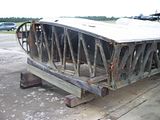You are essentially basing your entire claim on "I've seen more photos of shot up B-17s than I have of shot up Lancasters and the only reason that could be is because the B-17 is tougher."
No, I am not, and I have already stated as much. That's an oversimplification.
I'm basing it off a lot of stuff picked up and observed. I'm no expert but I'm saying this: I see denser framework, thicker frames, more ribs outboard of the fuel cells on the B-17, and the main spars look a HELL of a lot better than the lancaster's.
The 2 wings share a main box design out from the wing root. A front spar and a rear spar, with the framework connecting them, like rungs on a ladder. Add a rounded leading edge and a pointed trailing edge and you have the wing shape.
For the ribs between the spars, it looks to me like the B-17s are slightly thicker (depth to and from the camera, not left to right from the camera). this could be perception but even if they are the same thickness you have 7 vertical bars (with diagonals attached to them) on the B-17 between the front and aft main spars, but only 5 verticals (with accompanying diagonals) on the Lancaster.
B-17 (clickable thumbnail):

Lanc:


You can see it has more space between the framework.
You can also see part of the spar in that diagram. On the lancaster it's a couple of boxes separated by a thin sheet of metal to give it rigidity, kind of like an I-beam but with less "I" shape. It makes sense, but the support between top and bottom of the beam can be called flimsy compared to the setup on the B-17 wing.

In the previous B-17 ribs picture you saw part of this as well... This is how the main spar was set up on the B-17:

If you can't pick it out amongst the rest of the frame, here's a close-up:

So no, I am not basing this only on photo evidence. I'm basing it on logic and visual estimating and war stories and lack of war stories and photographic evidence of damage (separate from the war stories, but related) and general knowledge of the 2 aircraft in question. I said as much before but you've forced me to spell it out here. I hope all those images work.